Linda Ballou Shares Highlights, Photos of Her Recent Adventure to Costa Rica – Land of Divine Diversity
By Linda Ballou, NABBW’s Adventure Travel Associate
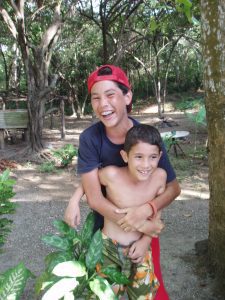
Linda’s shot of a couple of happy, young locals, or Ticos, as the Costa Rican natives call themselves.
Costa Rica, the poster child of eco-tourism, has so many fun, outdoor adventures options it’s hard to choose. Twenty-five percent of the country is preserved habitat to ensure the continuation of the unique flora and fauna found in species-rich forests. Multiple changes in altitude and temperature create many micro-climates that are responsible for Costa Rica’s diversity. Extending and gracious people, Ticos, as locals call themselves, offer guided outdoor adventures throughout their emerald-green country.
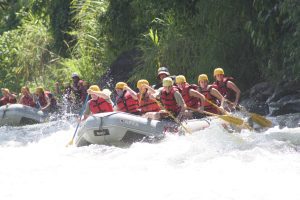
Rafting Costa Rica’s Pacuare River
Rafting the Class III to IV Pacuare River, not far from busy San Jose, was a high point in my tour. This energetic river carves a swath through towering buttresses, shaggy with ancient trees draped in luxuriant green foliage.
Flowering vines weigh down the limbs of the elder trees while ferns, mosses, orchids, and bromeliads nest in watery cisterns. The trees become a trellis for liana, bush ropes, passion flowers, and philodendrons—all hangers-on in the eternal quest for light.
On this glide through the dense, impenetrable jungle, I was warmed by the intense sunlight glinting off the backs of giant blue hummingbirds busy pollinating bright red Heliconia. Scanning the canopy for howlers or spider monkeys, I spotted a hairy three-toed sloth dangling from his perch high overhead.
The next stop, La Fortuna, nestled at the base of Arenal Volcano, offers a host of outdoor activities. The stalwart in my tour group embarked on a six-hour hike through the cloud forest along the Rio Celeste River, topped by a swim in a frosty crater lake. Others went for a chest-thumping eight-run zip-line glide through the tree canopy.
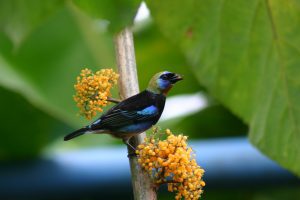
A giant blue bird captured by Linda during her Tico River Adventures experience.
I did a bit of birding on an intermediate hike to a lava flow that took place in 1992. One of the beauties of this trip is that people with disparate interests and different energy levels can find the perfect option for any given day.
We reunited in the afternoon for a plunge at the base of a staggeringly beautiful waterfall, capped off with a soak in an elaborate labyrinth of pools ranging from the polar plunge to the 102-degree melting pot at Baldi Hot Springs.
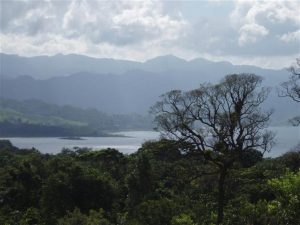
Linda’s shot of beautiful Lake Arenal.
I enjoyed a “bicyclist’s high” on a run with easy ups and heart-thumping downs on sweeping curves of the less-traveled road that traces Lake Arenal. A brisk, cooling wind blew off the man-made reservoir which provides clean drinking water for all.
I flew through the forest of ferns, elephant ears, and frilly trees with yellow blooms, past rivulets cascading to the shimmering lake below. I hit a traffic jam when a family of Coati, raccoon-faced critters with monkey-like tails, came out of the forest to beg shamelessly.
We stopped to check out a group of Howler monkeys making a huge racket in the tree canopy. When threatened, these monkeys are known to hurl feces at intruders, (with great accuracy), so I made sure not to overstay my welcome.
After fifteen kilometers, I turned in my bike and joined the others at an open-air café, where I enjoyed tilapia, a white fish, fresh caught in Arenal Lake, which was grilled to perfection, and completed with fresh veggies and rice.
Ticos, have embraced eco-tourism as a major source of income. So many opportunities for adventure and cozy quarters are offered throughout the country that it is impossible to explore them all in less than two weeks.
More than 25% of national land is protected in 27 national parks and 8 biological reserves, as well as in 63 wildlife refuges. Additionally, 27 private refuges serve as biological corridors for wildlife.
The country itself is a land bridge linking North and South America. Although Costa Rica covers only .03% of the earth’s surface, it provides habitat for 4% of the world’s estimated 13-14 million species of flora and fauna. Each day brings fresh discoveries and new challenges.
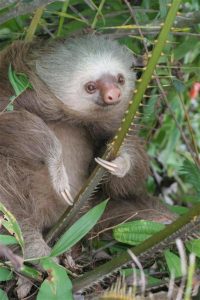
Linda spotted this sloth during her Tico River Adventures trip.
Cruising through the countryside between destinations allowed us to view parts of Costa Rica that are not preserved. A quilt of well-tended plots of fruits, vegetables, and coffee plantations interspersed with grassy pastures dotted with baggy-skinned Brahma cattle make up most of the countryside. Sadly, 95% percent of the private lands are bereft of forests.
No trip to Costa Rica is complete without a stop at the famed Monteverde Cloud Forest Biological Preserve. Our driver expertly navigated the narrow, rutted road to the top of the world making stops to point out wildlife along the way. Seemingly with eyes on four sides of his head, he spotted an ornate hawk-eagle, a Paca – a pig-like rodent with spots on his rust-colored coat like that of a fawn, and a pair of mating iguanas.
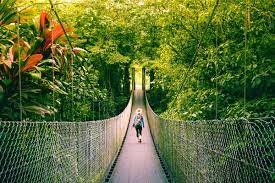
One of the hanging bridges Linda crossed in the famous Monteverde Cloud Forest. Stock photo.
We arrived at the Sunset House, overlooking the tiny hamlet of Monteverde, just in time to watch the sun drop into the sea shining in the distance. Those who had taken the Rio Celeste hike and missed the thrill of zip-lining through the canopy were given a second chance to experience Costa Rica’s answer to bungee jumping.
Being suspended in a harness from a 2,000-foot cable over gaping chasms was not for me, so I opted for the walk on a series of hanging bridges spanning the forest canyons, which allow an up-close and personal look at the fantastic array of plant life in the tree canopy.
I thought it a bit strange that, in this most famous of birding hotspots, not a Resplendent Quetzal nor even a “common brown thing” was in sight. Our naturalist guide told us it was because we were there at high noon, but I suspect it was the yelps of we humans, flying overhead at 50 mph, that kept the birds in less frequented parts of the forest. I took consolation in viewing the hundreds of hummingbirds flashing through the green, stopping to refuel on crimson blooms called Hot Lips.
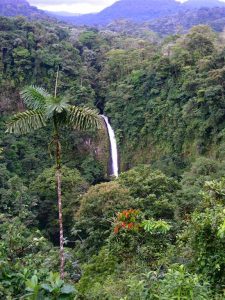
A waterfall in the Arenal region. Photo curtesy of Mike Grayford.
Should you want to retrace my steps, fly into San Jose, where most tours begin. There is also a direct flight from Los Angeles to Costa Rica that arrives at the Liberia Airport in the northwest corner of the country. This region is not as populated as the Southern parts of the country. From there, it is about 35 minutes to Tamarindo, a sleepy beach town, and a 3-4 hour drive to Monteverde.
When I return to the land of Pura Vida, or “Pure Life,” I will explore that part of the country. There is so much to see and do in Costa Rica you can’t do it in one trip. It is best to have a guide to navigate narrow mountainous roads. There are numerous tour companies available to ensure that you have a safe time exploring this land of divine diversity. Below are some excellent resources for more information in planning your own trip:
Important Links:
- Costa Rica Tourism Board — Host of tours and more
- Best of the Best Tour Company — a Costa Rica owned and operated by Ticos and featuring local guides

Books in Linda Ballou’s Lost Angel Series
Adventure travel writer, Linda Ballou, is the author of three novels and numerous travel articles appearing in national publications. Linda’s Lost Angel Walkabout–One Traveler’s Tales is the first installment in her Lost Angel Adventure trilogy. It is an armchair traveler’s delight filled with adventure to whet your wanderlust. Linda loves living on the coast of California and has created a collection of her favorite day trips for you in Lost Angel in Paradise. Lost Angel Unleashed, the third book in her travel series, is travel memoir that takes you on her most meaningful journeys and some destinations to die for… Learn more at www.LostAngelAdventures.com
You can learn more about her works of fiction at www.LindaBallouAuthor.com

 Linda's mission is to experience as many beautiful places on our planet as she can before they are no more. Travel tales relating her experiences while kayaking, horseback riding, sailing, birding and hiking about the globe have appeared in numerous national magazines. She had great fun collecting travel stories, and profiles of people she met in “naturally high places” for her book, Lost Angel Walkabout-One Traveler’s Tales. Her latest book Lost Angel Unleashed is the third book in her Lost Angel Trilogy
Linda's mission is to experience as many beautiful places on our planet as she can before they are no more. Travel tales relating her experiences while kayaking, horseback riding, sailing, birding and hiking about the globe have appeared in numerous national magazines. She had great fun collecting travel stories, and profiles of people she met in “naturally high places” for her book, Lost Angel Walkabout-One Traveler’s Tales. Her latest book Lost Angel Unleashed is the third book in her Lost Angel Trilogy

Leave a Reply
You must be logged in to post a comment.